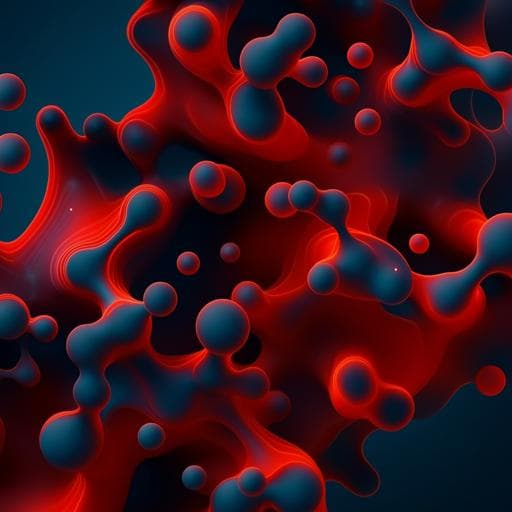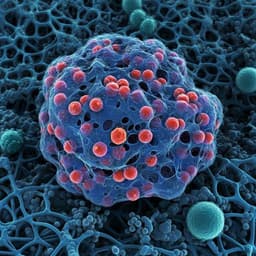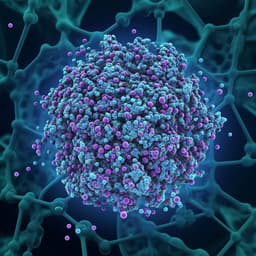
Chemistry
Diaryl-hemiindigos as visible light, pH, and heat responsive four-state switches and application in photochromic transparent polymers
M. Sacherer, F. Hampel, et al.
This innovative research by Maximilian Sacherer, Frank Hampel, and Henry Dube unveils a groundbreaking class of photoswitches, diaryl-hemiindigos, which respond to red light and exhibit remarkable thermal stability. With their impressive ability to switch directions, accumulate isomers, and respond to various stimuli, these compounds hold great promise for applications in molecular machines and smart materials.
~3 min • Beginner • English
Introduction
The study addresses the need for more versatile hemiindigo (HI) photoswitches by introducing diaryl-substituted HIs that expand functionalization beyond monoaryl-HIs. Photoswitches enable light-controlled functions across chemistry and biology, and indigoid chromophores are valuable because they respond to visible light and provide rigid geometries. Prior advances with hemithioindigo (HTI) showed that adding a fourth substituent at the central double bond unlocks new photoreactions, multi-state switching, and molecular machines. Monoaryl-HIs already offer near-quantitative bidirectional switching, red-light responsiveness, high extinction, and thermal bistability, but their structural diversity is limited. The research question is whether adding an additional aryl substituent at the central double bond (diaryl-HIs) can provide a short, modular synthetic access and deliver enhanced properties: green/red light responsiveness, strong photochromism, high isomer enrichment in both directions, high thermal bistability, tunable acid responsiveness with acid gating, and applicability in multi-state systems and materials. The purpose is to establish synthesis, quantify photophysical/photochemical performance, and demonstrate applications including four-state switching, chemical fueling, and photochromic polymers. The importance lies in expanding the structural and functional space of HI photoswitches for advanced responsive systems, mechanistic studies, molecular machines, and smart materials.
Literature Review
The paper situates diaryl-HIs within the broader field of molecular photoswitches, referencing rapid advances and applications in photopharmacology, catalysis, supramolecular assembly, and molecular machines. It highlights modified azobenzenes, hydrazones, Stenhouse dyes, imidazolyl-radical switches, and indigoid photoswitches as key recent developments, each with specific advantages. For indigoids, HTIs have achieved major milestones when a fourth substituent at the double bond was introduced, enabling observation of hula-twist and dual single bond rotation (DSBR), multi-state switches, photogearing, and molecular motors. Monoaryl-HIs with strong electron donors at the stilbene fragment show near-ideal switching with red-light responsiveness, strong photochromism, sizable quantum yields, and high thermal bistability; nitrogen substitution allows functionalization for chiroptical switches and ionic chromophores, with demonstrated biological applications (e.g., HIV-1 RNA binding). However, limited structural modification restricts their full potential. The authors argue that diaryl substitution, analogous to advances in HTIs and supported by ongoing structural modification efforts for monoaryl-HIs, should significantly elevate HI performance by providing additional substitution sites and controllable spatial relationships, facilitating tuning of photochromism and absorption.
Methodology
Synthesis: A concise, modular three-to-four-step route was developed. 1) Condensation of indoxyl acetate with commercially available aldehydes to access parent monoaryl-HIs (introducing R2) in high yields (compounds 5–8). 2) Chemoselective chlorination at the central double bond (position R1) with N-chlorosuccinimide (NCS) in aprotic solvents (typically THF, 23 °C), avoiding undesired electrophilic substitution on the indoxyl benzene; NBS and elemental bromine were ineffective or unselective. 3) Suzuki–Miyaura cross-coupling of the vinyl chloride with aryl boronic acids to install diverse aryl groups at R1, affording diaryl-HIs (1a–4a) in moderate to high yields. 4) Indoxyl nitrogen functionalization to install R3 via either N-alkylation (NaH, 1-iodopropane, DMF) to give N-propylated derivatives (1b–4b) or aza-Michael addition with methyl acrylate (DBU, MeCN, 50 °C) to give ester-functionalized derivatives (1c–4c). Crystallography (e.g., Z-1a, Z-3b) confirmed twisted diaryl geometries. Design principle: combine one electron-rich aryl (p-NMe2 aniline) with a second neutral/electron-poor aryl to form effective push–pull systems for photochromism and good E/Z differentiation. Photophysical/photochemical characterization: UV/Vis spectra of pure E and Z isomers obtained by deconvolution from mixtures with known compositions; spectra recorded across solvents (toluene, THF, MeOH, DMSO, DMSO/H2O) to assess solvatochromism and band separation. Molar absorption coefficients were determined for each isomer. Photoisomerization was quantified by UV/Vis and 1H NMR at multiple concentrations using LEDs from blue/green to red. Quantum yields were determined by the initial slope method at spectroscopic concentrations. Thermal behavior: Kinetics of thermal E↔Z isomerizations measured at elevated temperatures in toluene-d8 or o-xylene-d10 and extrapolated to 25 °C to obtain ΔG‡ values and half-lives; equilibrium compositions provided ΔG between isomers. Acid/base studies: UV/Vis and 1H NMR titrations with TFA (including TFA-d1) in toluene or toluene-d8 to probe acid-induced isomerization, identify protonated states (E-[HI-H]+ and Z-[HI-H]+), and demonstrate acid gating and chemical fueling; MS experiments confirmed monoprotonation under high acid. Polymer implementation: Thermal polymerization of styrene at 140 °C, followed by addition of HI (e.g., 1b, 4b) and casting into Petri dishes to obtain transparent polystyrene matrices. Photowriting with 520 nm light; erasing with 625 nm light, acid addition, or sunlight; long-term persistence assessed under indirect sunlight and in the dark.
Key Findings
- Modular synthesis: Three-to-four steps (condensation, NCS chlorination at R1, Suzuki–Miyaura cross-coupling, and N-functionalization) deliver diaryl-HIs (1a–4c) in good overall yields. X-ray structures confirm twisted diaryl geometries.
- Thermal bistability: Most derivatives exhibit high barriers with ΔG‡ >25 kcal mol−1 and half-lives ranging from hours to >100 years at 25 °C (extrapolated). Exceptions: 2b and 3c are more labile (minutes to hours). Increased steric hindrance at the non-p-NMe2 aryl increases thermodynamic stability of the bathochromic isomer. R3 substitution with stronger −I effects increases ΔG‡ (e.g., 1: from 25.3 to 31.9 kcal mol−1 by R3=(CH2)2CO2Me).
- Spectral properties and photochromism: E and Z isomers show well-separated visible absorption bands with strong color contrasts. Δλmax between isomers up to 55 nm (e.g., 2b) and generally large (30–55 nm across series). Molar absorptivities are suitable for switching (εmax ≈ 4,000–15,300 L mol−1 cm−1). Compared to monoaryl-HIs and diaryl-HTIs, bands are bathochromically shifted by up to ~30 nm; solvent polarity tunes hypso-/bathochromic shifts.
- Photoswitching performance: Strong isomer enrichments in both directions. Toward bathochromic species: often near-quantitative. Toward hypsochromic species with longer-wavelength light: 46–93% depending on derivative. Representative PSS data (toluene-d8 unless noted): 1b, 100% Z at 470 nm; 62–63% E at 625 nm (1b/1c). 4b, up to 87–88% Z at 660/625 nm and 81–89% E at 505 nm. 4c, 93% Z at 660 nm; 90% E at 490 nm. 2b, up to 92% Z (470 nm) and 91–92% E (625–660 nm). Increased solvent polarity slows photoconversion in DMSO but does not prevent switching.
- Quantum yields: Hypsochromic→bathochromic photoisomerization QYs ≈ 4–6% for 2b, 2c, 4b, 4c; bathochromic→hypsochromic QYs <1%.
- Structure–property trends: Stronger donor–acceptor cross-conjugation at the diaryl fragment enhances bathochromic shifts, photochromism, and bidirectional isomer enrichment. R3 substitution improves PSS compositions and photostability; −I substituents at R3 slightly increase thermal bistability.
- Acid/base responsiveness and four-state switching: Small amounts of acid accelerate thermal isomerization (e.g., E→Z for 4b); large excess TFA generates two distinct protonated states (Z-[HI-H]+ and E-[HI-H]+) with characteristic spectra. Protonated forms do not photoswitch (acid gating) but can be fully reversed by base (Et3N), restoring photoswitching. Chemical fueling: For 4b, TFA then Et3N at −78 °C yields 91% of the thermodynamically less stable neutral E-4b. For 1b, analogous sequence at 23 °C yields 85% Z-1b.
- Materials application: Embedding 1b and 4b in transparent polystyrene retains switching. Photowriting with 520 nm produces persistent patterns; erasure achievable with 625 nm light, acid addition, or sunlight. Written features persist for hours under indirect sunlight and days–weeks in the dark.
- Best-performing derivatives: 2c, 4b, and 4c combine high thermal bistability, red/green light responsiveness, strong photochromism, high PSS enrichments, and the highest QYs within the series; 1b and 1c show extreme thermal stability (>100–199 years half-life extrapolated) and notable acid resistance while retaining photoswitching in protic media.
Discussion
Introducing a second aryl substituent at the HI central double bond overcomes the limited functionalization of monoaryl-HIs and delivers a versatile platform with tunable electronic interactions and steric profiles. The resulting diaryl-HIs achieve the target property set: visible-light operation (including red), high thermal bistability, strong bidirectional isomer enrichment, and significant photochromism, corroborating the design premise inspired by diaryl-HTIs. Structure–property relationships clarify that donor–acceptor cross-conjugation across the double bond and appropriate R3 substitution are key to maximizing band separation, PSS selectivity, photostability, and thermal barriers. Steric bulk on the non-donor aryl stabilizes the bathochromic isomer thermodynamically. Acid/base control adds orthogonal stimuli, enabling two additional, spectrally distinct protonated states with reversible acid gating of photoswitching. Moreover, acid/base sequences allow chemical fueling to enrich thermodynamically less stable neutral isomers (e.g., 91% E-4b), expanding functional operation modes beyond simple photoisomerization. Translation to materials demonstrates that these properties persist in solid polymer matrices, allowing rewritable, color-contrasting photochromic inscriptions erasable by light, acid, or sunlight. Collectively, the findings validate diaryl-HIs as multi-stimuli, four-state molecular switches suited for advanced applications and mechanistic investigations.
Conclusion
A straightforward, modular synthesis affords diaryl-hemiindigos with an additional aryl at the central double bond, enabling broad structural variation and late-stage functionalization. These photoswitches exhibit visible/red-light responsiveness, high thermal bistability, strong E/Z band separation and photochromism, and robust bidirectional isomer enrichment. Acid and base provide two further stimuli, granting access to two protonated, spectrally distinct states and reversible acid gating; sequences of acid/base additions enable chemical fueling to populate less stable neutral isomers. Implementation in transparent polystyrene demonstrates practical photowriting and erasure modalities. The expanded structural space and multi-stimuli control open avenues for multi-state devices, molecular machines, mechanistic photochemistry, and smart materials. Future work can explore broader substitution patterns, optimize quantum yields (especially for the bathochromic→hypsochromic direction), and integrate diaryl-HIs into complex functional systems.
Limitations
- Quantum yields for bathochromic→hypsochromic photoisomerization are below 1% for the studied series, which may limit efficiency for some applications.
- Certain derivatives (e.g., 2b, 3c) are thermally less stable, with half-lives in the minutes-to-hours range at 25 °C.
- Protonated states abolish photoswitching (acid gating), requiring base for recovery; operational windows must manage acid/base concentrations.
- Electron-rich substrates can complicate chlorination (e.g., side reactions for R2 = p-NMe2 during NCS chlorination), necessitating solvent and concentration control.
- Molar absorption coefficients are lower than in monoaryl-HIs due to increased torsion between aryls, potentially reducing optical density in thin samples.
- Some measurements can be hampered by photodegradation (not all values determined), and photoconversion slows in highly polar solvents like DMSO.
Related Publications
Explore these studies to deepen your understanding of the subject.







